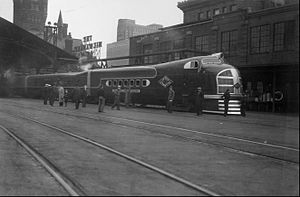
The City of Portland was a named passenger train operated by the Union Pacific Railroad between Chicago, Illinois, and Portland, Oregon. It started service in June 1935, using the streamlined M-10001 trainset. With only one set of equipment the train left each of its terminals five times a month. The route used Chicago and Northwestern trackage between Chicago and Omaha, Nebraska until 1955, replaced by Milwaukee Road trackage.

A streamliner is a vehicle incorporating streamlining in a shape providing reduced air resistance. The term is applied to high-speed railway trainsets of the 1930s to 1950s, and to their successor "bullet trains". Less commonly, the term is applied to fully faired upright and recumbent bicycles. As part of the Streamline Moderne trend, the term was applied to passenger cars, trucks, and other types of light-, medium-, or heavy-duty vehicles, but now vehicle streamlining is so prevalent that it is not an outstanding characteristic. In land speed racing, it is a term applied to the long, slender, custom built, high-speed vehicles with enclosed wheels.

The City of Denver was a streamlined passenger train operated by the Union Pacific Railroad between Chicago, Illinois, and Denver, Colorado. It operated between 1936 and 1971. From 1936–1955 the Chicago and North Western Railway handled the train east of Omaha, Nebraska; the Chicago, Milwaukee, St. Paul and Pacific Railroad handled it thereafter. The train was the fastest long-distance train in the United States when it debuted in 1936, covering 1,048 miles (1,687 km) in 16 hours. For almost its entire career its principal competitor was the Chicago, Burlington and Quincy Railroad's Denver Zephyr. When Amtrak assumed operation of most intercity trains in the United States in 1971, it discontinued the City of Denver, preferring to use the Burlington's route between Chicago and Denver.
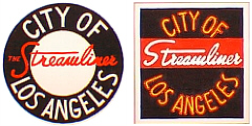
The City of Los Angeles was a streamlined passenger train between Chicago, Illinois, and Los Angeles, California via Omaha, Nebraska, and Ogden, Utah. Between Omaha and Los Angeles it ran on the Union Pacific Railroad; east of Omaha it ran on the Chicago and North Western Railway until October 1955 and on the Milwaukee Road thereafter. The train had number 103 westbound and number 104 eastbound.
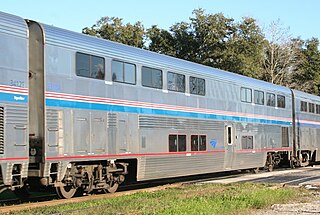
A passenger railroad car or passenger car, also called a passenger carriage, passenger coach, or passenger bogie (India) is a railroad car that is designed to carry passengers. The term passenger car can also be associated with a sleeping car, a baggage car, a dining car, railway post office and prisoner transport cars.

The M-10000 was an early American streamlined passenger trainset that operated for the Union Pacific Railroad from 1934 until 1941. It was the first streamlined passenger train to be delivered in the United States, and the second to enter regular service after the Pioneer Zephyr of the Chicago, Burlington and Quincy Railroad.

The General Pershing Zephyr was the ninth of the Chicago, Burlington & Quincy Railroad's Zephyr streamliners, and the last built as an integrated streamliner rather than a train hauled by an EMD E-unit diesel locomotive. It was constructed in 1939 with bodywork and passenger cars by Budd Company and diesel engine, electric transmission, power truck, and other locomotive equipment by General Motors Electro-Motive Corporation. Because its intended Kansas City to St Louis route passed near the birthplace and boyhood home of famous World War I General John J. Pershing, the train was named after him. The power car was named Silver Charger, after Pershing's horse Charger, while the passenger cars were named after United States Army badges of rank—Silver Leaf, Silver Eagle, and Silver Star.

The Union Pacific Railroad's M-10001 was a diesel-electric streamlined train built in 1934 by Pullman-Standard with a power system developed by General Motors Electro-Motive Corporation using a Winton 201A Diesel engine and General Electric generator, control equipment and traction motors. It was the UP's second streamliner after the M-10000, their first equipped with a diesel engine and was a much longer train than its three-car predecessor. All cars were articulated—trucks were shared between each car. It was delivered on October 2, 1934, and was used for display, test and record-setting runs for the next two months before being returned to Pullman-Standard for an increase in its power and capacity, following which it was placed into service as the City of Portland train. It has been nicknamed "The Banana".

The Union Pacific Railroad's M-10002 was a diesel-electric streamliner train built in 1936 by Pullman-Standard, with prime movers from the Winton Engine division of General Motors Corporation and General Electric generator, control equipment and traction motors. It was the UP's third streamliner, and the last turret-cab streamliner.

The Union Pacific Railroad's M-10003, M-10004, M-10005, and M-10006 were four identical streamlined 2-car power car diesel-electric train sets delivered in May, June, and July 1936 from Pullman-Standard, with prime movers from the Winton Engine Corporation of General Motors and General Electric generators, control equipment and traction motors. One was for the City of San Francisco, two were for the City of Denver, and one was a spare set intended for both routes. In 1939, M-10004 was split and converted into additional boosters for the other sets, now renumbered CD-05, CD-06, and CD-07, all running on the City of Denver. The M-10001 power car became the other third booster. In this form, the three power sets ran until they were replaced by E8 locomotives in 1953, at which point they were scrapped.

The Pioneer Zephyr is a diesel-powered trainset built by the Budd Company in 1934 for the Chicago, Burlington & Quincy Railroad (CB&Q), commonly known as the Burlington Route. The trainset was the second internal combustion powered streamliner built for mainline service in the United States, the first such train powered by a diesel engine, and the first to enter revenue service. The trainset consists of one power/storage car, one baggage/RPO/buffet/coach car, and one coach/observation car. The cars are made of stainless steel, permanently articulated together with Jacobs bogies. The construction incorporated recent advances such as shotwelding to join the stainless steel, and unibody construction and articulation to reduce weight. It was the first of nine similarly built trainsets made for Burlington and its technologies were pivotal in the subsequent dieselization of passenger rail service. Its operating economy, speed, and public appeal demonstrated the potential for diesel-electric powered trains to revitalize and restore profitability to passenger rail service that had suffered a catastrophic loss of business with the Great Depression. Originally named the Burlington Zephyr during its demonstration period, it became the Pioneer Zephyr as Burlington expanded its fleet of Zephyr trainsets.

The Nebraska Zephyr was a streamlined passenger train operated by the Chicago, Burlington and Quincy Railroad between Chicago, Illinois; Omaha, Nebraska; and Lincoln, Nebraska, from 1947 to 1971. Until 1968, the service was provided by two Twin Cities Zephyr articulated trainsets — the "Train of the Gods" and "Train of the Goddesses" — that became synonymous with it. The Nebraska Zephyr was one of many trains discontinued when Amtrak began operations in 1971. The "Train of the Goddesses" set is preserved at the Illinois Railway Museum in Union, Illinois.

The Denver Zephyr was a streamlined passenger train operated by the Chicago, Burlington and Quincy Railroad between Chicago, Illinois, and Denver, Colorado. In peak years it ran to Colorado Springs. It operated from 1936 to 1973. The Denver Zephyr continued operating after the Burlington Northern Railroad merger in 1970. BN conveyed the train to Amtrak in 1971; Amtrak merged it with the Denver–Oakland City of San Francisco to form the San Francisco Zephyr and dropped the "Denver" name in 1973.

The UAC TurboTrain was an early high-speed, gas turbine train manufactured by United Aircraft that operated in Canada between 1968 and 1982 and in the United States between 1968 and 1976. Amtrak disposed of the trains in 1980. It was one of the first gas turbine powered trains to enter service for passenger traffic, and was also one of the first tilting trains to enter service in North America.
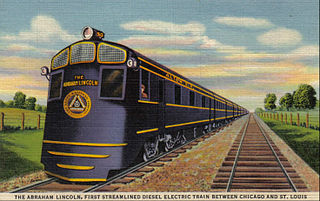
The Abraham Lincoln was a named passenger train operated by the Baltimore and Ohio Railroad from 1935 into the 1960s. The "Abe Lincoln" ran between Chicago and St. Louis on the B&O's subsidiary Alton Railroad. The train later passed to the Gulf, Mobile and Ohio Railroad, and then finally to Amtrak, which retained the name until 1978. Service between Chicago and St. Louis is now known by the umbrella term "Lincoln Service". This train was the first streamlined passenger service to travel the 284 miles between Chicago and St. Louis, with Joliet, Bloomington-Normal, Springfield and Alton in between. Passengers can get a glimpse of the Mississippi River between Alton and St. Louis.

The City of Miami was a seven-car coach streamliner inaugurated by Illinois Central Railroad on December 18, 1940. Its route was from Chicago to Miami a total distance of 1,493 miles (2,403 km).
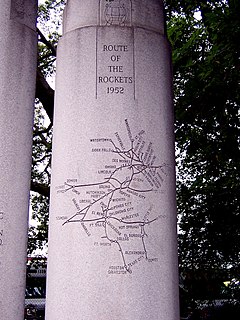
The Chicago, Rock Island and Pacific Railroad Rockets were lightweight, streamlined diesel-electric passenger trains built by the Budd Company. These six trains were the first streamlined equipment purchased by the Rock Island, as well as being its first diesel-powered passenger trains. Four of the trains consisted of three cars each, the other two each had four cars.

The Land O'Corn was a streamlined passenger train operated by the Illinois Central Railroad between Chicago, Illinois, and Waterloo, Iowa, from 1941 until 1967. Its inception was due in no small part to John W. Rath of Ackley, IA and part owner of the Rath Packing Co. of Waterloo, Iowa as well as a member of the Illinois Central's board of directors. It featured a wide range of equipment over its existence, including self-propelled Motorailers and steam locomotives, before finally adopting conventional diesel locomotives and lightweight cars. The Illinois Central discontinued the Land O'Corn in 1967; Amtrak later operated the Black Hawk over part of its route.

The Green Diamond was a streamlined passenger train operated by the Illinois Central Railroad between Chicago, Illinois and St. Louis, Missouri. It operated from 1936 until 1968. It was the Illinois Central's first streamliner. Initially it operated with Illinois Central 121, the last of the 1930s fixed-consist articulated streamliners built in the United States.
